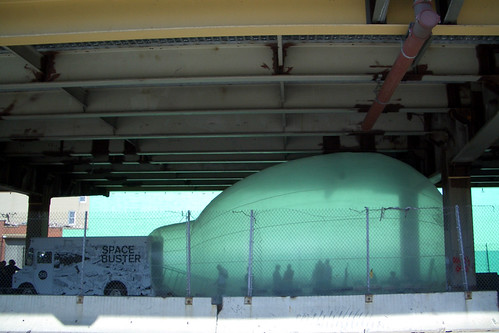
[historical bubbletecture, top to bottom: 1960's inflatable by Jersey Devil (source); L: The Environment Bubble, 1965 by Reyner Banham & Francois Dallegret (source) R: Pneumakosm, a pneumatic dwelling unit, 1967 by HAUS-RUCKER-CO (source); Clean Air Pod,1970 by Ant Farm (source); page from Ant Farm's Inflatocookbook (PDF source)]
Of those exploring inflatable architecture in the sixties and seventies, Ant Farm was the most prolific, gearing a number of projects around air and plastic, and even creating an Inflatocookbook (PDF link). Fellow Americans Jersey Devil also explored what they called Inflatables in the early seventies, likewise created as "happenings" that stood out in their urban contexts, like alien crafts landed amongst the stone, glass and grass. In Austria upstarts like Coop Himmelb(l)au and HAUS-RUCKER-CO explored the possibilities of pneumatic dwelling units, yet without clients or sites they failed to get beyond the prototype stage. Even critic Reyner Banham got in on the act, combining the ideas of Bucky Fuller and Marshall McLuhan in a transparent igloo he designed with Francois Dallegret.

[Michael Rakowitz's paraSITE | image source]
The inflatable trend faded as fast as it started, finding use primarily for temporary stagings and art installations. Michael Rakowitz's paraSITE (1998-ongoing) can be considered part of the latter, though it engages the social, economical and political directly in the use of inflatable structures to house homeless individuals. By hooking the deflated plastic to a building's HVAC vent, a small enclosure is created, with the expelled air inflating the double wall. Importantly, in terms of my exploration of this architectural element here, the air used to shape and heat the space does not come into contact with the inhabitant; it is not part of the space itself, like the Ant Farm and Jersey Devil examples above. The design of the paraSITE's plastic shell is therefore much more complex, with many more seams, and even windows in the one on the left.

[Alexis Rochas's Aeromads | image source]
SCI-Arc's Alexis Rochas created Aeromads, installations from 2006 that questioned the domestic realm and harked back to ideas from 40 years ago, though Rochas's designs utilize the computer to create more complex forms. He "considers the idea that one’s home is a malleable, movable environment that can be deflated and fit into a suitcase, then travel to a new location with its owner. [source]" Again, air inflates what creates the enclosure.

[OMA's Serpentine Pavilion, 2006 | image source]
OMA and Cecil Balmond's 2006 Serpentine Pavilion in London can be taken as a purely symbolic attempt at reintroducing inflatables into architectural discourse. The inflatable enclosure sits above the main space, inaccessible and indirectly visible from below. But from afar the enclosure stands out, visible from a distance. The possibilities of using inflatable walls for architectural enclusre is not explored here, but like a moored hot-air balloon, the pavilion marks a space and place with minimal means, one of the advantages of air as a medium for architecture.

[Raumlabor's Spacebuster under the BQE | image source]
Raumlabor's Spacebuster has been in the news a lot lately, when it made its way around New York City on a ten-day tour. Spacebuster is part of the German architects' ongoing investigation of unused urban spaces, which started with inflatables in 2006 with the Kitchen Monument and includes last year's Glow Lounge.

[Raumlabor's Spacebuster under the BQE | image source]
Their truck-towed events in New York included film screenings, performances and community meetings, the last under the BQE in Brooklyn the day before Spacebuster left town. Situated in a typically unused space, the community meeting used the opportunity to investigate other ways of doing the same. The possibilities of guerilla engagement with urban sites is certainly clear in Raumlabor's latest undertaking; one need only drive the truck to a parking lot, underpass or some other un/underused site and take advantage of the bubble until the cops arrive. The fact that the air and inhabitants occupy the same space, a la Ant Farm's and Jersey Devil's inflatables, makes this design suitable for these temporary happenings, but not necessarily a good precedent for further architectural investigation beyond the engagement of urban sites.

[mmw's kiss the frog | image source]
mmw architect of norway's 2005 kiss the frog was a temporary art pavilion linking four institutions in Oslo. The aptly-titled design is structured in parts like a tire, with powerful fans pushing fresh air into the spaces. The pressure difference between inside and outside air means the former pushes out on the PVC skin, giving the pavilion its shape. In designs like this, which require a constant supply of air and the energy to do so, necessitates a well-sealed skin and hatch-like access points to keep as much air inside as possible.

[Kengo Kuma's Tea House | image source]
The Tea House Kengo Kuma designed for the Museum für Angewandte Kunst in Frankfurt (yes, that one) a couple years ago is a double-wall membrane embedded with LEDs for nighttime use. Rooted in similar design investigations in his home country at the same time as Americans and Austrians were doing the same, most notably in the Fuji Pavilion at Expo 1970 in Osaka, the small yet complex project is documented in a book. This product that might be as or more influential than what is once again another temporary inflatable enclosure. The refinement of Kuma's design, filled like a 3d air mattress, points to an elevated level of sophistication possible with air as supporting structure. The double-wall enables openings to have free access, without worry and energy expended on keeping the air inside, and the high-tech skin provides for longer durability.
The above projects continue the temporary nature of inflatable architecture, but they point to their continued use in the coming years. Perhaps we'll see their longevity increase, as techniques of using air as a structural medium and membrane technologies improve.
No comments:
Post a Comment